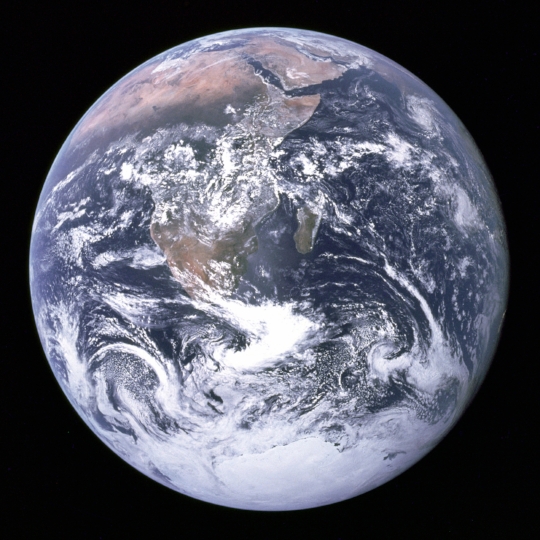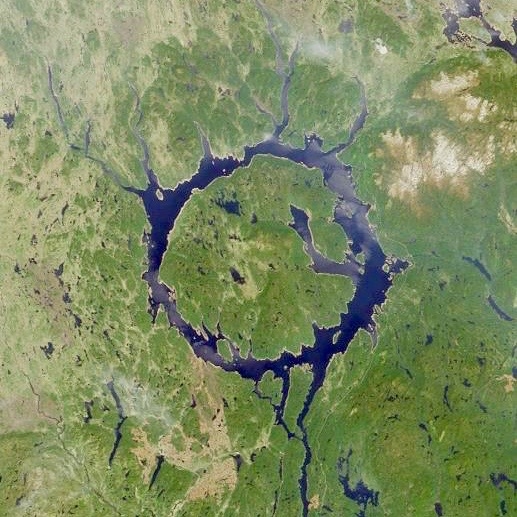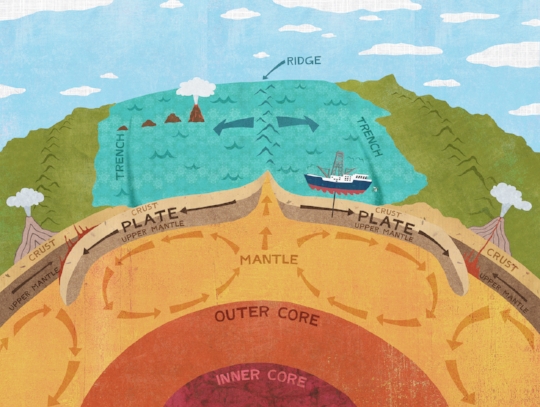If you look at the Earth, the Moon, and Mars one after another…
…you may notice that our neighbors in space look like they have a bad case of acne, while the Earth looks like it has been well supplied with Oxy-10.
Most of the acne-looking things you see on the Moon and Mars are impact craters created by asteroids and smaller meteorites that struck the Moon and Mars a long time ago.
Since the Moon is right next to us and Mars is pretty close to us too (well, not close enough that you can ride your bike to it, but close to us compared to everything else in space), why is the Earth not also covered with impact craters? Are we just the luckiest planet in the solar system and asteroids keep missing us?
We are lucky in many ways (for example, we are the only planet in the solar system where you can get ice cream), but we aren’t luckier than other planets when it comes to asteroids. It’s just harder to see the impact craters on our planet.
We actually aren’t completely without visible impact craters. If you go out in space and look down at the Earth, you can see a few, like the Manicouagan Crater in Quebec, Canada (It’s not too hard to find on a map, either).
There are even a couple impact craters that you can drive right up to and see from your car, like the Barringer Crater in Arizona (which is also called rather generically and somewhat inaccurately Meteor Crater).
But, for the most part, all of the Earth’s impact craters are either hidden, like the 110-mile wide Chicxulub Crater is, or long gone.
There are a few reasons why Earth is better at hiding its impact craters than the rocky planets and satellites around us.
One reason is that, unlike the Moon and Mars, the Earth has a lot of this:
There is so much liquid water on Earth that 71% of the planet is covered by it. That means that an asteroid heading towards Earth has a really good chance (I would guess a 71% chance) of landing in water. An asteroid that crashes into the ocean leaves behind an impact crater that is underwater and thus much harder for us to find, much less see.
Impact craters in the seafloor are also hard to find because seafloor rock tends to be recycled every hundred to two hundred million years (which sounds like a long time to recycle something, but is actually not that long when you consider Earth’s entire history) Because of plate tectonic forces, almost all seafloor rock eventually sinks into the superhot interior of the Earth, where it then becomes gooey, superhot, molten rock (which eventually may come back-up to the surface through a volcano somewhere, and that’s how it gets recycled). You can see all this happening in the illustration below.
Since seafloor rock has been consistently melted and recycled for a few billion years, there are many impact craters that used to be in the seafloor, but they melted and disappeared long ago.
There is not evidence that plate tectonic activity has happened much in Mars’ past, or at all on the Moon, so the impact craters on the Moon and Mars do not get melted and recycled the way they do on Earth.
Not all asteroids that hit the Earth land in the ocean, though. Some do hit land. Even though land rock does not get recycled very often, impact craters on land are pretty hard to find too.
One way that craters get hidden on land is by volcanoes erupting near them and covering them with lava rock. This does not just happen on Earth, though. Volcanoes have also erupted on the Moon and Mars and probably covered up a bunch of craters. Those dark splotches on the Moon that are called “seas” are actually lava flows.
And Mars has the biggest known volcano in our solar system, Olympus Mons. It has spewed a bunch of crater-covering lava during its lifetime.
A reason craters get hidden on Earth, and not so much on the Moon or Mars, is again the abundance of liquid water on our planet. Over millions and billions of years, rain, streams, and rivers break tiny chunks of rock and sand off impact crater structures and then carry those broken bits away. (Wind actually does this too). This process is called erosion. Over that length of time, erosion can carry so much of an impact crater away that you will not even know that a crater was once there.
Since craters are basically bowls in the Earth, they can also be buried and hidden over time by things other than lava. That is what happened to the Chicxulub Crater. It is considered the best-preserved large impact crater on Earth, but you wouldn’t know it to look at it, because it is buried under a bunch of stuff.
Some of that stuff is dust or sand carried into the crater by the wind and water, but most of it comes from something else that we have a lot of on Earth, but these things are not found on the Moon or Mars (well, at least so far we haven’t found any of it there). I am talking about living things.
The Chicxulub Crater is partially at sea and partially on land (though the part at sea is on the continental shelf, so it technically is on land rock too). The crater’s size and location are indicated on the map below by the blue circle.
On the land-side of the crater, everything from bacteria to lichens to plants to animals eventually returned to the crater after the impact and were able to survive there. Except of course until they died. When that happens, their remains create soil by mixing with the sand and dust that is carried into the crater by wind and water. Over 66 million years, a lot of soil has built up in the land-side of the Chicxulub Crater, so much so that you can stand on the Crater and have no idea a crater is there.
The living plants currently growing over the crater are not making it obvious there is a crater there either. Besides blocking the view, they help hold the soil in place that is covering the rocks and making it very difficult to dig to the rocks (because of this, plants may actually be the archenemies of geologists).
These plants and Mayan ruins are on the Chicxulub Crater.
On the sea-side of the crater, the remains of living things have also filled up the crater, except in the ocean, the filler is mainly fossilized plankton shells. The ocean if filled with microscopic creatures that make their own shells, like these guys below who are called foraminifera:
These shelled plankton are so abundant that, when they die, they continuously cover the seafloor with piles of shells. In some places in the ocean, these piles of microscopic shells can be hundreds of feet deep. Over time, some of these piles of shells can form limestone rock. This was what happened on the sea-side of the Chicxulub Crater. The rocks from the impact were covered with hundreds of feet of plankton fossils and limestone made-up of plankton fossils.
As good as the Earth is at hiding and destroying impact craters, scientists have found evidence of 188 of them on our planet, some of which are visible on the surface and some of which are buried, like the Chicxulub Crater. That nowhere near compares with the 300, 000 or so impact craters known to be on Mars or the literally millions of impact craters on the Moon. But scientists, including some on the Chixculub Crater team, are still looking on Earth for undiscovered impact craters, and they, or even you, have a good chance of finding more in the future.
To learn more about how scientists study the Earth, read my free eBook Uncovering Earth's Secrets.
Online References and Resources:
Center for Lunar Science and Exploration. Education resources page.
http://www.lpi.usra.edu/exploration/training/resources/?view=illustrations
NASA SpacePlace. "Why is the Moon so scarred with craters?"
http://spaceplace.nasa.gov/craters/en/
Science. "Earth's Colossal Crater Count Complete."
http://www.sciencemag.org/news/2015/06/earths-colossal-crater-count-complete
Universe Today. "Impressive Craters on Earth."
http://www.universetoday.com/19616/earths-10-most-impressive-impact-craters/
USGS. "This Dynamic Earth: The Story of Plate Tectonics."
http://pubs.usgs.gov/gip/dynamic/dynamic.html
Photos and Images:
Click the photos and images used above to find their sources. If the photo does not link anywhere, it was taken by Kevin Kurtz. If the image is an illustration of plate tectonics, then it was drawn by the talented Alice Feagan, which is found in the eBook Uncovering Earth's Secrets that she and Kevin created together.













